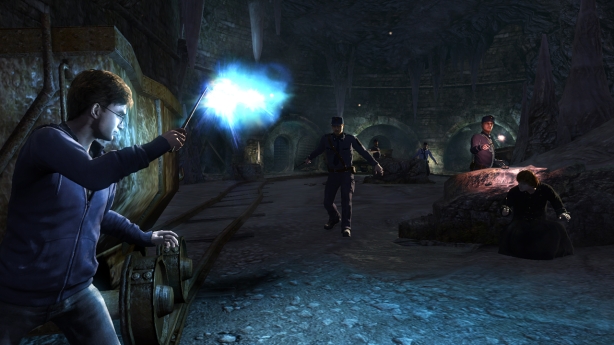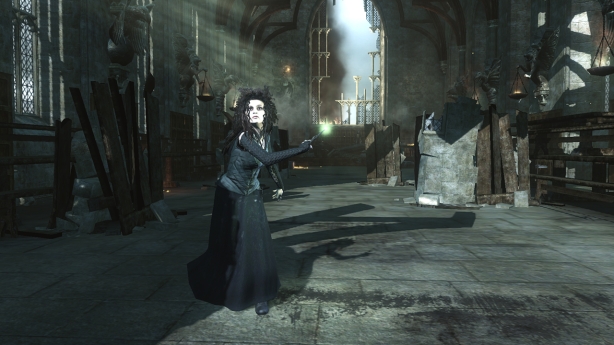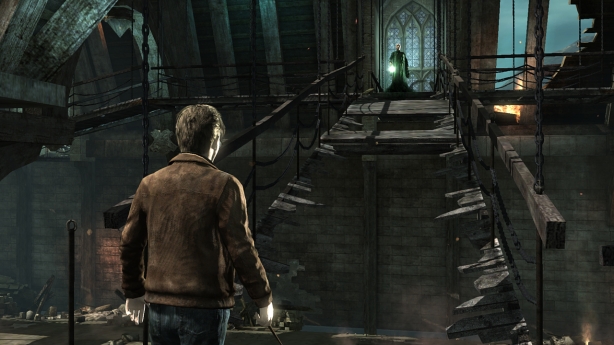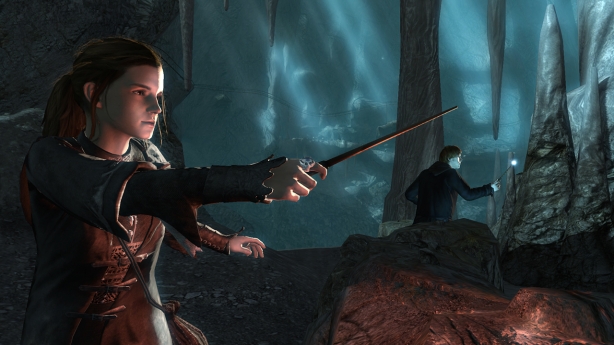Harry Potter And The Deathly Hallows: Part 2 Review
 Game: Harry Potter And The Deathly Hallows: Part 2
Game: Harry Potter And The Deathly Hallows: Part 2
Developer: Bright Light Studio
Publisher: Electronic Arts
Available on: Xbox 360, PlayStation 3, Wii, DS, Windows PC (Xbox 360 Version Reviewed)
With the release of the final Harry Potter film this month, there comes the inevitable videogame tie-in. Electronic Arts has been working on the Harry Potter series of games since its inception – so you should think they would have learnt a thing or two by now about how to make a good game set in the Wizarding world J. K. Rowling has created. The titles have consistently sold well, but have been a rather mixed bag critically – with average review scores actually getting lower and lower as time has gone by. After the release of LEGO Harry Potter showed us how fun a game set in and around Hogwarts really could be, how has EA responded?
STORY: If you have already seen the films, or read the books, then you will know where we stand. If you haven’t done either of those two things, then you probably aren’t interested in this game anyway. We pick up halfway through the concluding book in the Harry Potter saga, where Harry and his two closest friends Ron Weasley and Hermione Granger have set out by themselves on a mission to track down and destroy a series of Horcruxes; items that contain part of the soul of Dark Wizard and Harry’s arch-nemesis, who threatens to destroy the entire wizarding world – Lord Voldemort. By destroying all of these items, they hope to be able to defeat Voldemort once and for all.
The story of the final book is an epic one that probably contains more action and suspense than any of the previous instalments. That is probably why both the film studio and game developers chose to split it up into two parts – that and the increased profits expected from two releases, rather than one. You would expect the game to include all of the most dramatic moments of the game and reproduce them faithfully for the player to experience. However, the game developers have chosen to set up the game almost entirely as a cover-based third-person shooter. By limiting the action to this gameplay style, you seriously limit the variety in the levels, and with that, the possibility for reproducing scenes accurately. This means that whilst all of the important events in the film do occur in the game, most of these are altered and extended so they can fit into the gameplay style. This often involves long treks through dark caves, simply to reach a location that would have been cut-to instantly in the film. Of course, concessions such as this have to be made in most adaptation games, in order to make them playable and not just an interactive movie, but it needs to be handled in a creative and imaginative way to stop the levels becoming irrelevant.
GRAPHICS: Having the film IP at their fingertips, you would imagine Bright Light Studio could acquire full face and body scans from the actors involved, allowing for an intense level of detail and high quality animations. Having access to concept artwork and early film footage, the sets should convey all of the cinematic power and drama as those seen on the big screen. Well unfortunately, if you want to play this title, prepare to be disappointed.
When it comes to the supernatural or non-human inhabitants of the Harry Potter universe, Bright Light hits it out of the ball park. Goblins and Giants look like they have come straight from the screen, or were put together by the same CGI artists who worked on the movies. But when we move onto the human characters, the quality and realism takes a nose-dive. Ok, Harry is easy to recognise (what with his circular spectacles and scar) but Hermione looks nothing like Emma Watson, and don’t even talk about Professor McGonagall; Maggie Smith never looked so bad. You would have thought that EA would get clearance to scan faces into the game, and if they did, the end result is far from satisfactory.
Moving onto the levels, and whilst there is a certain atmosphere lacking in some of them, these are all clearly recognisable from scenes in the film. Some stand out more than others and have clearly received more love and attention. The Chamber of Secrets, which is only visited very briefly both in the game and the source material, looks suitably dank and spooky, with a lot of the little details you remember from the earlier films. The Hogwarts Bridge stage really recreates the scale of the wooden structure successfully, and the drama of the scene is enhanced by the setting. But walk through Hogsmead or the caves of Gringotts Bank and you could be in any other cover-based shooter. At times, this even looks like Gears of War, with wands. Strategically placed rocks are strewn around to provide cover, but the levels are unimaginative and straightforward, with no real navigational choice. Even the more successful areas are very linear, and a little more exploration and more exciting areas to discover would have improved the overall experience.
SOUND: The sound design in the game suffers from a similar problem that the character modelling did. Only a handful of the actors from the films actually provide the corresponding voices for their in-game characters. Of the main three Wizards, only Rupert Grint reprises his role as Ron, and whilst the Harry voice over artist is very convincing, once again Hermione is far from satisfactory. The majority of big name actors such as Maggie Smith and Alan Rickman don’t appear and are replaced by mostly sub-par soundalikes, which really detracts from the immersion in what is meant to be a movie-like experience. Stangely, Gary Oldman is credited with voicing his character, but that appearance is so brief, it could easily be lifted directly from the movie. In some cases, it would have been best for characters to remain silent, rather than to use voice actors who sound so badly off-base when it comes to impersonating the original actors. This is made worse by the repetition of the same lines of dialogue as you play through levels.
Music and sound effects are (as you would expect) very well executed. All of the original film score is wisely adapted to fit in with the levels, and where extra scoring has been created, it ties in to the main themes from John Williams and seamlessly links together. This does help to draw us back in to the cinematic atmosphere, and with sound effects such as spell-casting sounds, which also seem to have been sourced directly from the film, this never detracts from the experience.
GAMEPLAY: As stated at the start of this piece, the game plays out largely as a third-person shooter, making use of a cover system for shielding yourself from enemy fire and recharging health. The other levels are made up of boss battles, which take the form of Wizarding duels of sorts, and chase levels where you are running away from on-rushing water, or a collapsing bridge for example.
Throughout the different levels, players will learn different magic spells which they can then use to defeat their enemies or to protect themselves. These are each assigned to one of three face buttons, with a second double press also being assigned to each. This does make remembering which button to either tap or double-tap to select a spell somewhat difficult, but the pause menu will always show you a key to which is which if needed. Some spells create a shield, others are good for breaking shields, however most are simply attacking spells that, when fired, resemble a basic gun, an automatic rifle and a rocket launcher, to name a few. The levitation or disguise spells that feature so heavily in previous films and books don’t appear in the game, the spells chosen here are simply the ones that fit best into the “shooter” mechanic.
The cover system isn’t too bad, what with players sticking to their cover with a simple button press. Combine this with the assisted aiming, and popping up from behind cover to take out the evil wizards becomes a straightforward affair. Perhaps too straightforward, as you will soon find yourself simply spamming the fire button, between pressing the aim button again to switch targets. Little skill is called into play when aiming at the enemy and the only thing that really shakes up the system is when you need to break an enemy shield by switching spells, or when an explosive spell would be useful to clear out a few bad guys at once. You will settle into a routine of a few spells that you find most effective, and some spells will sadly remain under-utilised, as there is no call to implement them in attack. Couple this with the fact that almost every level contains door opening sequences where you must protect a friend whilst they open a door, and the game doesn’t stretch the possibiilites of level design very far.
As you progress through the game, players will take control of all three main characters, as well as several professors and less important students. It is interesting to be able to control some new people, but the spell learning progression remains in place for all characters you control, meaning that when you control Professor McGonagall several levels into the game, she actually possesses less spells than under-achieving student Neville Longbottom, when you step into his shoes several stages later. This is clearly illogical, and once again makes the feeling of immersion somewhat redundant.
The duel boss scenes are simply the same mechanic as the main shooting quests, but limited to one small area and with only one or two enemies, who have their own health bars. These are simply a case of whittling down your enemies, whilst trying to duck into cover every now and then in order to recharge your health. These all follow fairly set patterns and once you’ve figured them out, beating the boss becomes quite tedious as you wait for the energy bar to drain. The chase levels are exactly that. Hold the analog stick as you run toward the screen, to escape whatever is chasing you. You will need to dodge left and right to avoid obstacles, and some levels add in an enemy wizard who you must shoot at, otherwise they will slow you down. Let the chaser catch up with you, and you will have to start the level again. This is hard to judge, as obstacles sometimes appear very suddenly in front of you, and enemies can catch up very quickly after one mistake, but they are thankfully short, and as the game has no “lives” system, players will not be punished greatly for repeated deaths.
Previous games in the series have added in side missions or free exploration of the Hogwarts School as extra diversions which add variety to the gameplay. However in this instance Bright Light Studio chooses to scale back all optional extras, and the main story is all we get in the campaign mode. There is no deviation from the main quest (other than to find collectable items which unlock new challenges, music and character models on the main menu) and all of these quests follow the formulas laid out above except for one of the third-person levels that, as well as being a shooter, asks the player to play as Seamus Finnegan, and plant bombs. Perhaps a somewhat non-pc decision, and this does little to spice up the stale formula of these third-person levels.
The only extra mode aside from the story is the challenge mode. Unlocked by collecting specific items in the main levels, these are levels (or portions of levels) that players have already completed. The player must re-play them and try to complete them in as quick a time as possible, in order to achieve medals, varying from bronze to silver, etc. This mode adds nothing else to the game, it is simply a time trial mode for previous stages.
LONGEVITY: Firstly, there is no multiplayer whatsoever, neither online or offline. The only online feature included is leaderboards for the Challenge Mode levels, so users can compare and compete with their friends and other players, in order to achieve the best times possible for each stage. Whilst the old-school score based elements of beating each others best time and one-upping your friends could add some length to the title, as mentioned earlier, the challenges are all simply sections from earlier levels you have already played, possibly on multiple occasions. The desire to go back and repeatedly complete portions of uninspiring levels is minimal, and once you have completed the main story once, there is little to draw players back in. The usual Achievements would normally extend the life of the game further, but so many of these could be achieved with one high-difficulty level playthrough, and none of them are inventive enough to make Achievement hunting an enjoyable side quest.
VERDICT: Unfortunately for a series that has become the most successful in the history of cinema, its gaming counterparts just don’t match up. Some have at least shown a level of ambition, letting players explore a fully rendered Hogwarts School or including Kinect-based spellcasting for instance (no matter how poorly it was implemented). But Deathly Hallows: Part 2 just seems to lack the ambition and imagination that has been strived for previously.
For source material that is so inventive, there should have been endless ways to bring a Wizarding game to life, but Bright Light has taken the obvious option here by simply slapping the franchise license onto a shooter engine. Certain parts of the game have been handled well, with the environments and sound design in general being very impressive. But for a videogame, it is the gameplay that is the core of the experience, and in this case it is sadly lacking. Even though the film franchise is over, perhaps the gaming one will continue. I hope so, as there is still a goldmine of material waiting to be uncovered and implemented properly. This game just can’t manage it. Maybe after another year or two at Hogwarts School of Wizarding, the Harry Potter Videogame series may be able to make a better account of itself.










